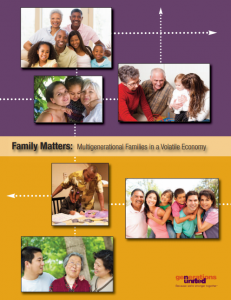 Download the Executive Summary
Download the Executive Summary
Download the Full Report
Today more than 51.4 million Americans of all ages – or about one in six – live in multigenerational households, a more than 10% increase since the start of the Great Recession in 2007. Some multigenerational families choose to live together; others form because of the widespread impact of the nation’s economic downturn and uncertain recovery.
For many, the main motivator is compassion. When elderly relatives become frail or have trouble making ends meet, adult family members take them into their homes and become caregivers while often experiencing economic stress themselves. When young adults cannot find work or have trouble caring for their children, they come home to their parents – calling to mind a line from one of Robert Frost’s poems: “Home is the place where, when you have to go there, they have to take you in.”
Whatever the reasons, multigenerational households are an increasingly important part of the socioeconomic fabric of the United States. This represents a reversal of the long-term trend towards living in nuclear families – one that creates both challenges and opportunities for policymakers and the private sector.
The recommendations include lawmakers :
- Exploring innovative housing options for multigenerational families
- Improving supports and services for caregivers
- Protecting and preserving the Affordable Care Act (ACA))
- Strengthening Social Security and protecting benefits for all generations